Bernburg an der Saale is located in Saxony-Anhalt and was the seat of the Anhalt-Bernburg family. If you stroll through the city, you will discover several places that remind you of this time.
There is a Historical City Tour, which presents individual places with very informative panels. We first set out in Bernburg’s “Bergstadt” district.
On the way in the “Bergstadt” of Bernburg
Click on the button to load the content from www.komoot.de.
Bernburg Castle
Above the Saale River on a sandstone rock stands the Renaissance castle with the castle terraces, the bear’s kennel and the Eulenspielturm.
Presumably, a circular castle with rampart and moat already stood on this very spot in 961. A “Brandanburg” is mentioned in a deed of donation by Otto I.
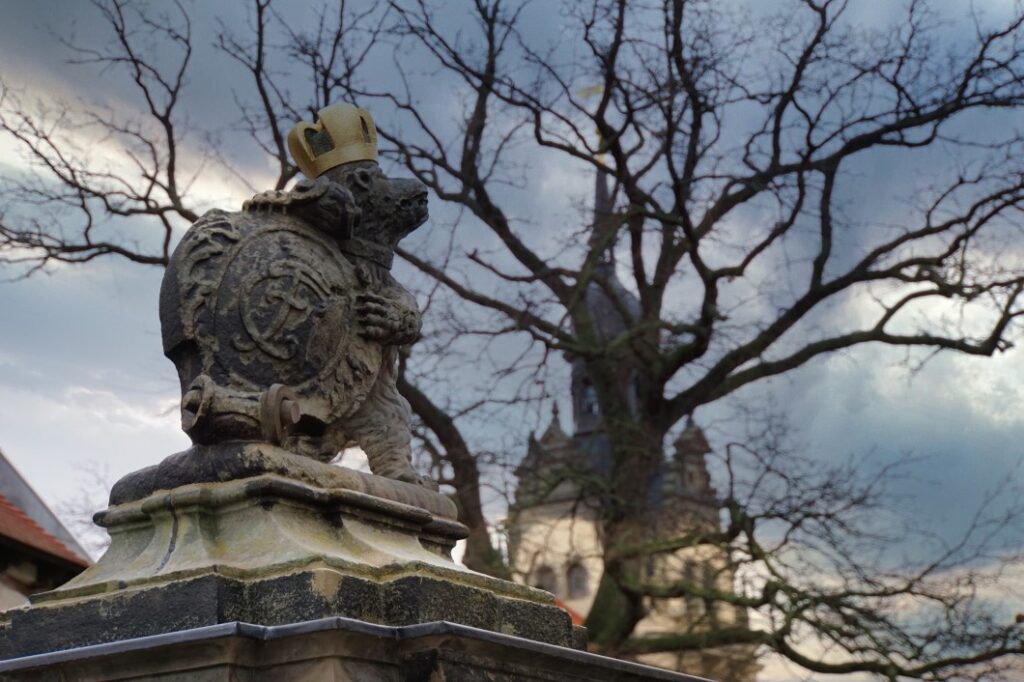
Around 1138 the castle, now known as “Berneburch”, was the widow’s seat of the mother of the market count Albrecht the Bear from the house of the Ascanians. The castle was burned down during disputes and only rebuilt in the second half of the 12th century as a Romanesque castle. The Eulenspiegenturm, the mighty keep in the castle courtyard, was also built at this time. The Eulenspiegelturm can be visited, more details can be found in our article “Till Eulenspiegel in Bernburg”.
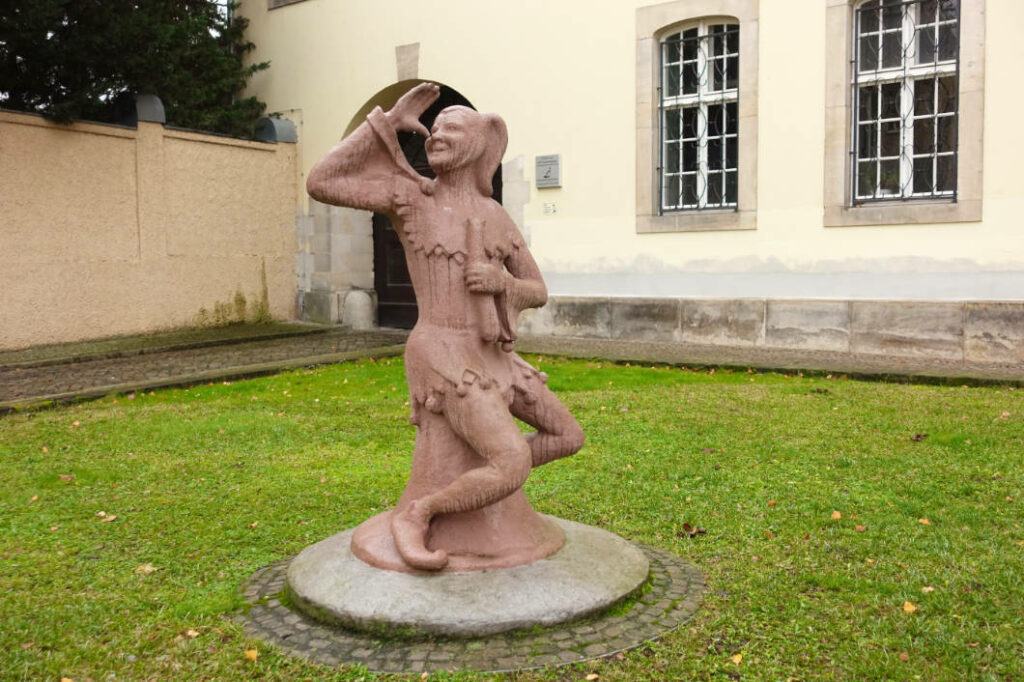
Standing in the castle courtyard, you will discover many elements from different times on the buildings. Every lord of the castle built a little here and a little there. For example, in 1538/39 Prince Wolfgang of Anhalt had the Wolfgangbau, now the western part of the nave, built. This is characterized by round oriels with beautiful ornaments and one should have a beautiful view over the river valley.
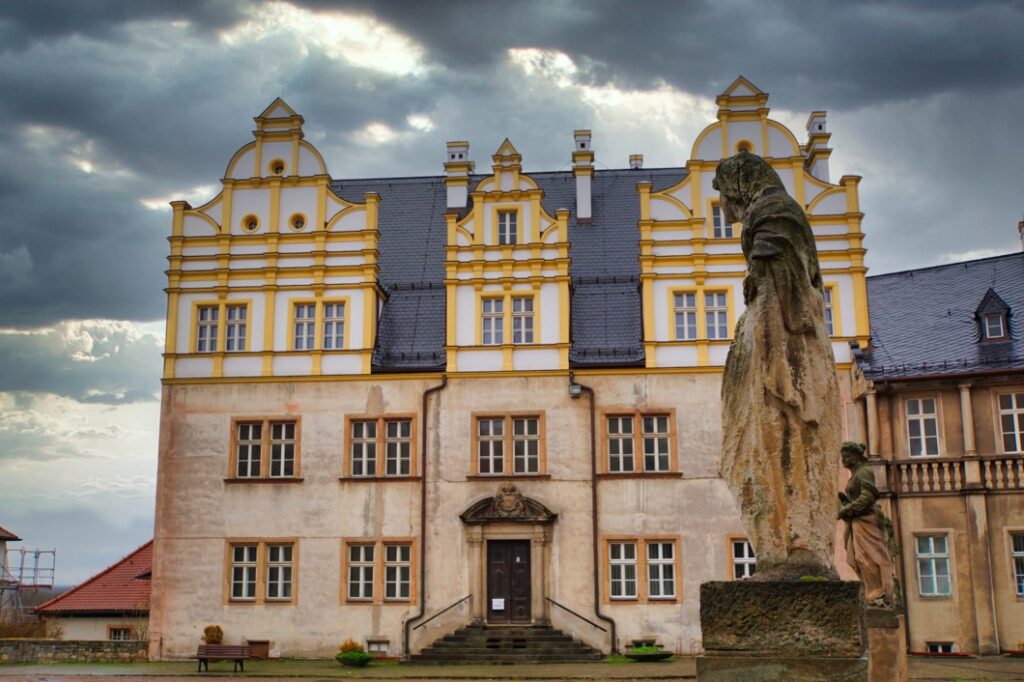
From 1567, Prince Joachim Ernst von Anhalt had a two-story residential building erected as an eastern extension of the Wolfgang Building. This is how today’s nave came into being. When Joachim Ernst moved his residence to Dessau, Bernburg lost importance and with the extinction of the Bernburg line in 1863, the heyday of the castle was over.
In 1860, a bear pit for a Russian brown bear was created in the former moat. In 2018, the brown bear still living there and until then cared for by the Bernburg Zoo was euthanized due to illness. Today, bears are no longer kept here.
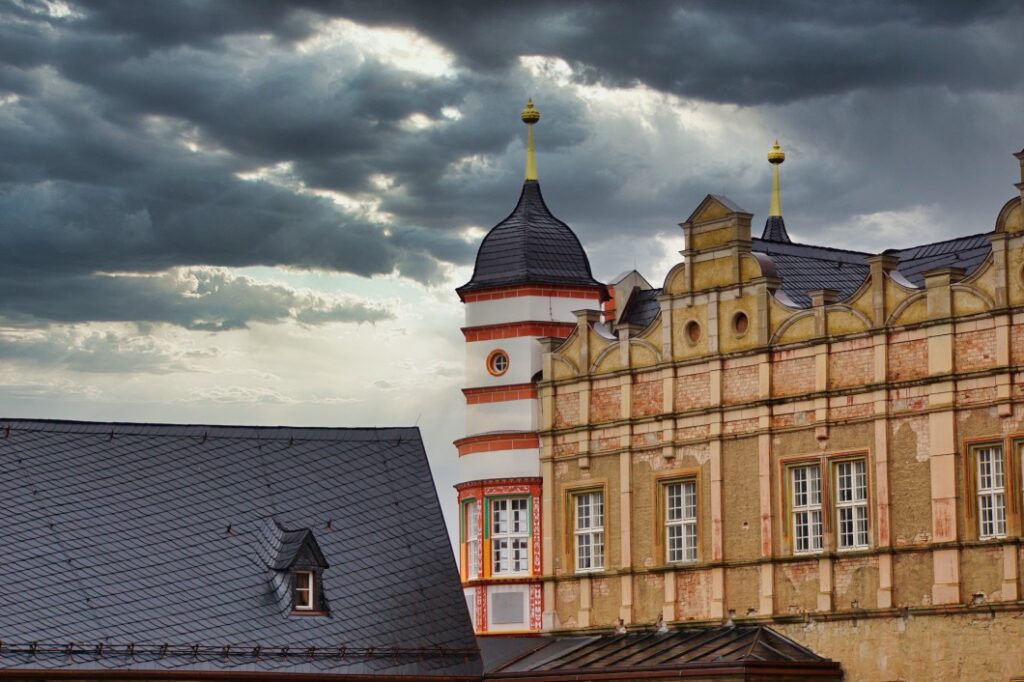
During our visit to Bernburg, construction was underway in the castle. The castle museum is to be reopened in 2021. So we were left only with a view of the castle courtyard and the wonderful view from the free lookout point of the terrace.
Address:
Schlossstraße 24
Former ducal riding arena
If you leave the castle grounds, you will discover an elongated building. In 1756/57, the then Prince of Anhalt-Bernburg had the ducal riding arena built, which was later rebuilt and extended. From 1919, the building was converted into an administrative building, today it is part of the town hall.
Address:
Schlossstraße 11
Carl-Maria-von-Weber-Theater
The ducal playhouse has been called Carl-Maria-von-Weber-Theater since 1954.
In 1827, the building was commissioned by Duke Alexius Friedrich Christian of Anhalt-Bernburg. Great artists gave guest performances in the theater, such as the violin virtuoso Niccoló Paganini in 1829.
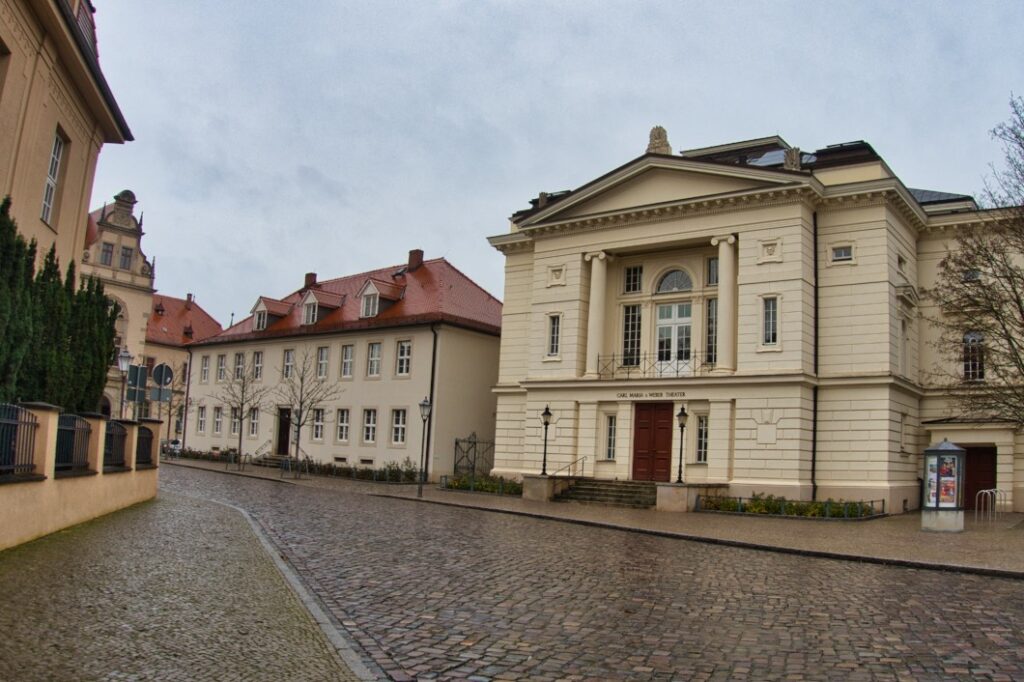
After extensive renovation, the auditorium was refurbished in 1997 to its 19th century design. 340 spectators can see here today mainly guest performances.
Address:
Schlossstraße 20
St.Aegidien Castle Church
Next we passed the castle church of St. Aegidien. In 1375 this church was mentioned in a document for the first time. The oldest parts are of Romanesque origin and in this church is the princely tomb of the Anhalt-Bernburg family.
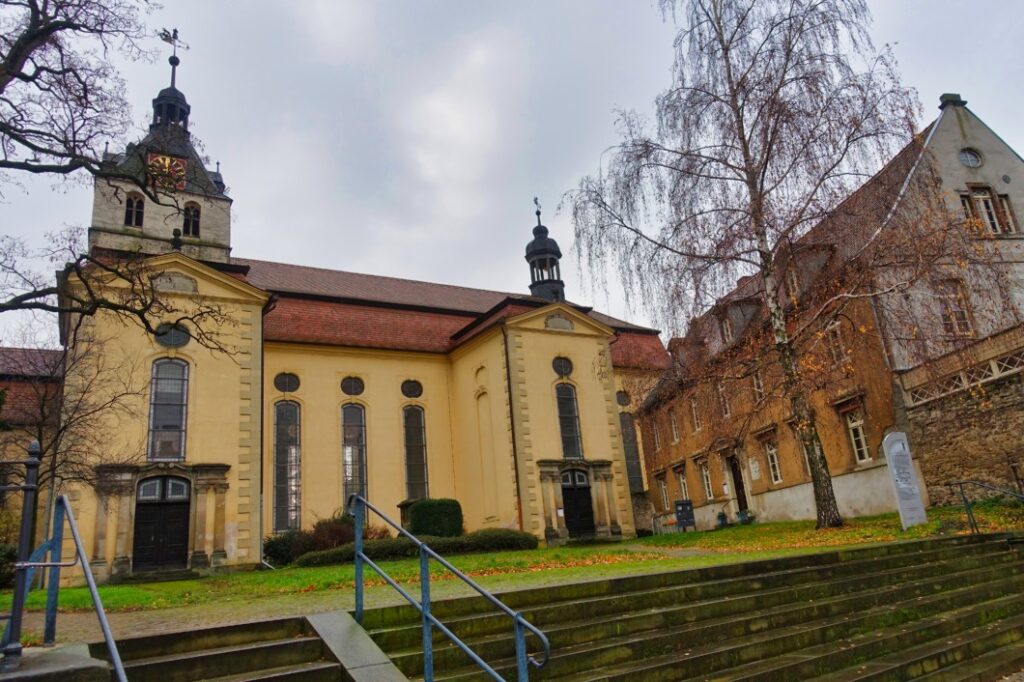
While we were standing in front of the church taking some photos, the church door was just unlocked and so we could go inside. I always like to admit it – visiting churches is something special for me. I discover something in every church that I like, am often overwhelmed by the beauty and impressed by the simple interior rather than the pompously overloaded naves. But what awaited me in this church, I had not expected.
In 2013, the castle church was remodeled as part of an art project. Sacred objects, the organ and all the pews were removed. Scaffolding was erected and the church was repainted. First, the artist Moritz Götze designed the ceiling of the church. It shines in blue and everywhere yellow stars were mounted from enamel.
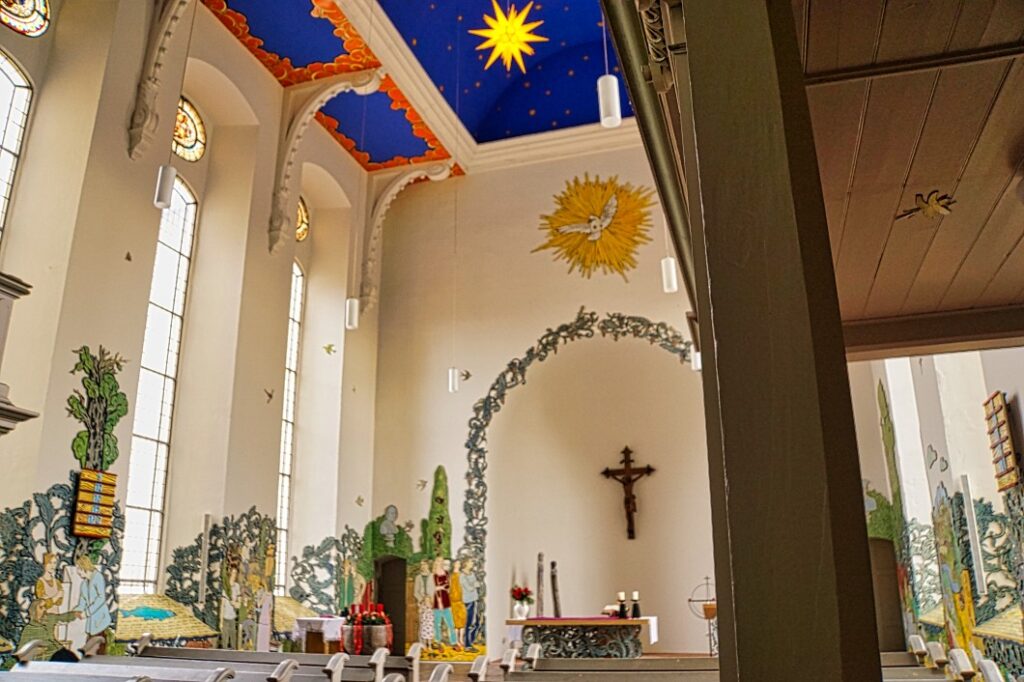
Subsequently, the artist designed one side wall after the next, in which he hung large-scale enamels. The final step was the design of the altar wall and after 3 years a festive service could be celebrated in the newly designed church on Easter 2016.
I have never seen a church designed like this. Colorful and modern pictures pick up church themes and present them vividly. I almost felt like I was in a gallery and not in a church.
Address:
Schlossstraße 7
Former ducal orangery
On our way in the direction of the Talstadt, we walked past the former orangery. Today, the building is used as a gymnasium for the neighboring high school.
Address:
Schlossgartenstraße 14
Away from the Historical City Tour in the Bergstadt
In the Bergstadt there is a long pedestrian zone. If you walk along it, you will get to the Karlsplatz. There is not only a sundial, but also a world clock. It has been on the square since 1977 and shows the times of cities in different countries.
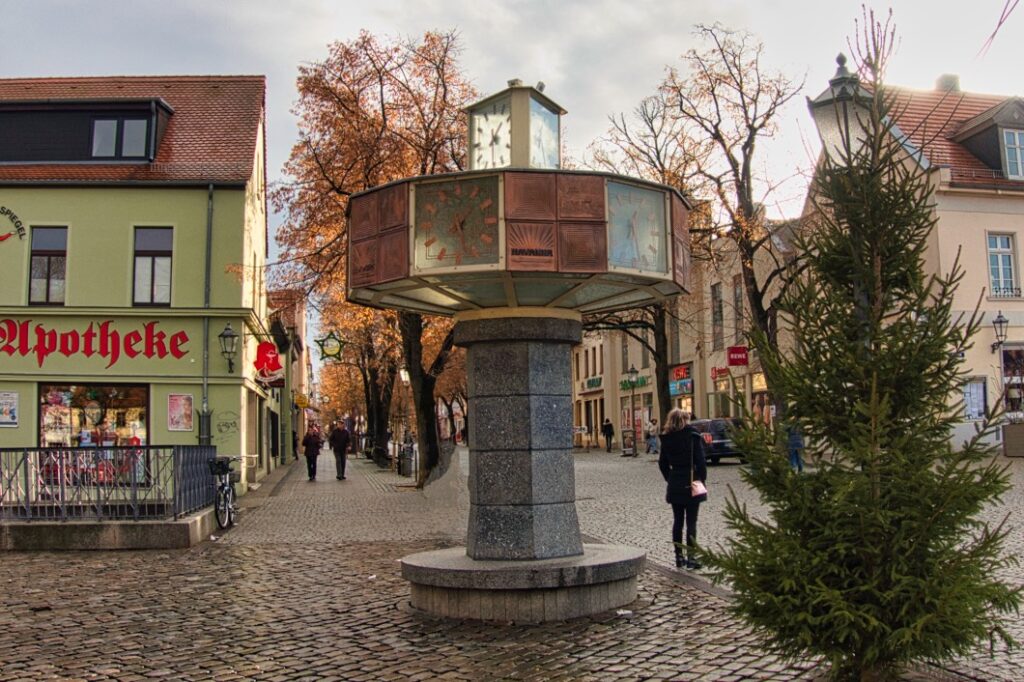
We continue walking along the pedestrian zone and come to a very striking work of art. The water feature “Stille Post” consists of eight sculptures by the artist Altenstein, who placed it here in 1998. It starts with the image of a bear in front of a model of a castle and shows the spreading of news until the last sculpture of a bear being freed.
Finally we reach the Saale bridge. With a view to the lock and an old factory building we enter the Talstadt of Bernburg.
On the way in the Talstadt of Bernburg
The Talstadt is located on the other side of the Saale and, as the name suggests, lies much lower than the hilly Bergstadt.
Here the historical city tour continues.
Click on the button to load the content from www.komoot.de.
Columns of the former bridge guard
Just behind the bridge there are four columns. I think they stand there somehow “wrong”, they do not fit so to the environment.
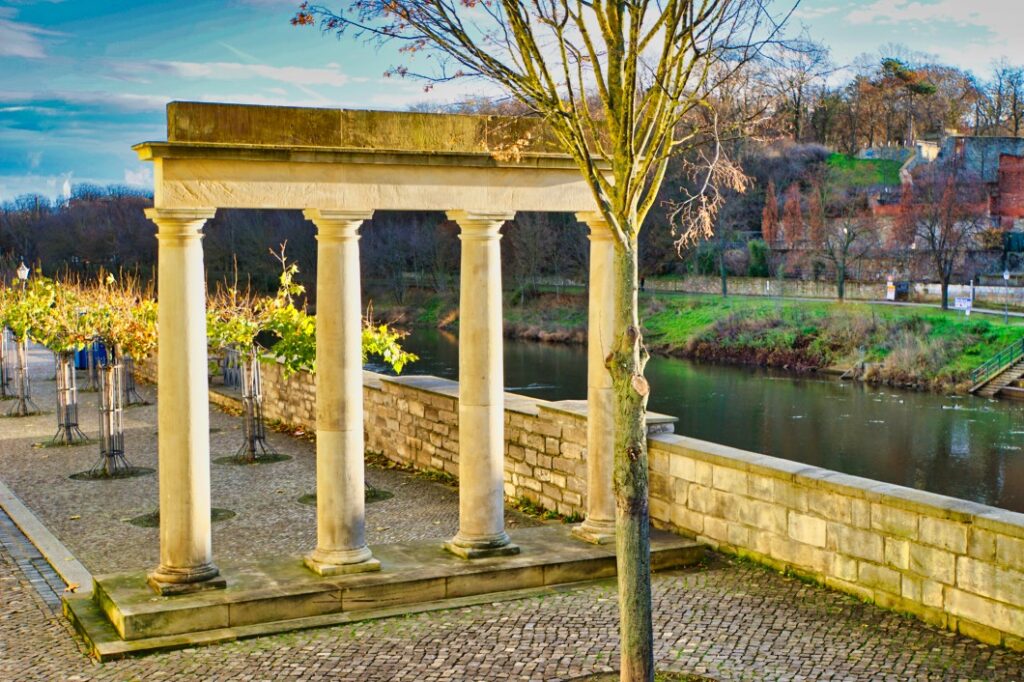
The columns date back to the 19th century and once supported the canopy of the bridge customs guard. In 1934, the new reinforced concrete bridge over the Saale was built and the bridge toll station was demolished. Only the columns were rebuilt.
In the evening the columns are beautifully illuminated .
Address:
Wachgasse 1
Oldest residential house of Bernburg
At the market there are remains of the oldest residential house in Bernburg. It dates back to 1550 and the half-timbering has been preserved until today. Originally, the house stood in a completely different place in Bernburg. There it was demolished in 1979 and unfortunately not rebuilt in its original state at the market in 1982.
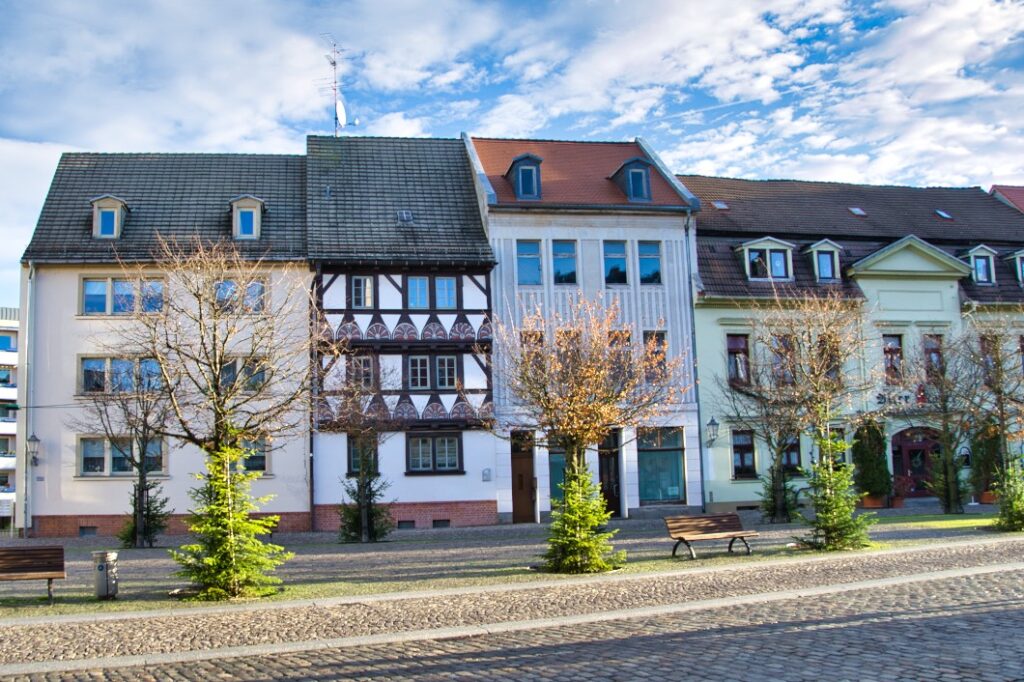
I think the half-timbering is beautiful. Oh yes, if you look closely, you will notice that the house has no entrance to the market. This was created during reconstruction on the other side of the house.
Address:
Markt 23
Old Town Hall
At the market you can see the Old Town Hall. I find the bears with the coats of arms on both sides of the clock especially beautiful. One of the coats of arms (to the right of the clock) shows the city coat of arms of Bernburg.
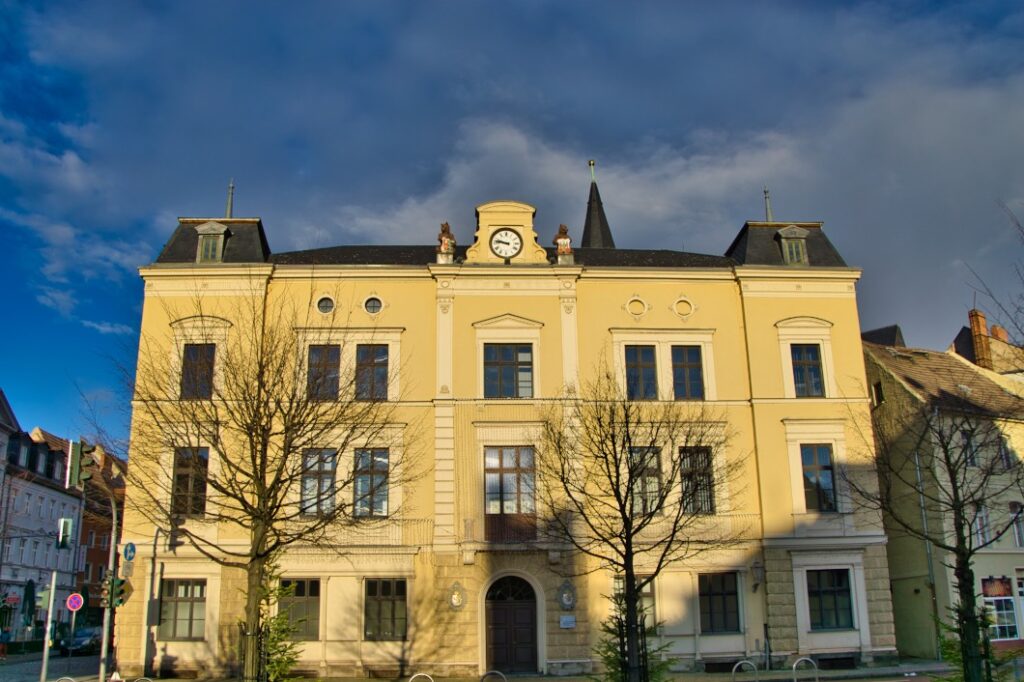
The building was used for many years as a town hall, later as a dormitory and today by the Anhalt University of Applied Sciences.
Address:
Markt 17/18
Green pharmacy
In 1775, the pharmacist Schulze had the town house built in Bernburg. Today there is still a pharmacy in the building, it is said to be the oldest pharmacy in the city.
Address:
Breite Straße 115
St. Mary’s Church (Marienkirche)
What a steeple! I have rarely seen anything so massive on a church!
St. Mary’s Church is a Gothic church from the year 1228.
It is noticeable that the tower and nave look as if they have sunk into the ground. The entrance in the tower is lower than known from other churches. This is due to the fact that the floods of the Saale River in the Middle Ages repeatedly washed away soil. This soil was not removed after the floods had stopped.
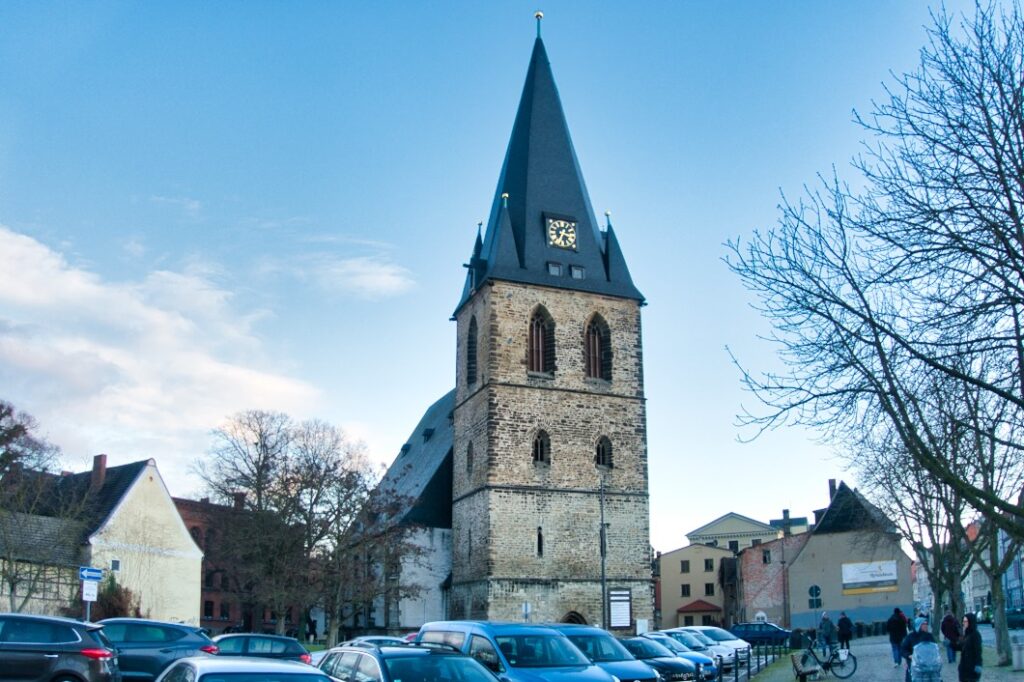
We were not in the church. But it is supposed to be especially beautiful when the morning light shines through the church windows.
Address:
Breite Straße 81
Church St.Nicolai
We passed the church of St. Nicolai on the way to our next destination. It was built as a parish church of the new town in the second half of the 13th century.
Address:
Breite Straße 81
Waldauer Flutbrücke
From the very beginning, the Talstadt had to struggle with the consequences of the Saale flood. It was urgently necessary to give the inhabitants of the village Waldau (now a district of Bernburg) the possibility to cross the flood plain of the Röße.
Until the late Middle Ages, the Röße formed the main branch of the Saale, today the area is drained.
If flooding occurs today, the Saale flows back into its old riverbed. In 2013, for example, the Waldau flood bridge (Flutbrücke) formed the only safe connection from the valley town, which was largely under water.
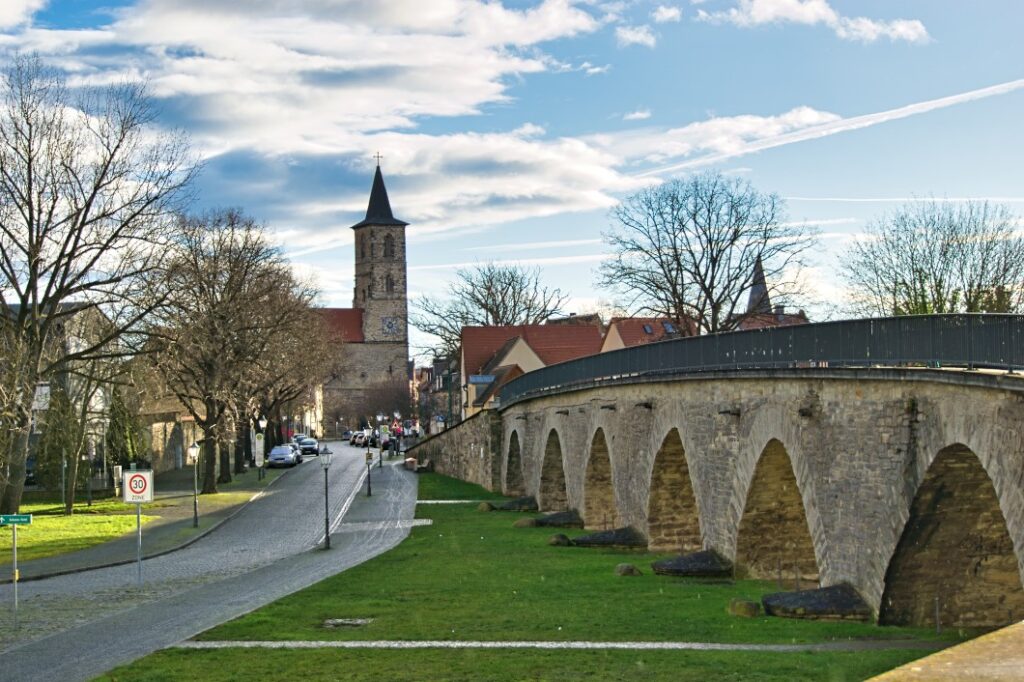
In 1644, the first flood bridge was built in Bernburg. It formed the connection of the long-distance trade route from Magdeburg to Halle. It was still made of wood and was destroyed several times by the flood or ice damage.
It was followed by a stone bridge in 1787. The 6-yoke structure has been preserved almost unchanged to this day. Today, the bridge is opened at high water for car traffic, which can then reach the valley town unharmed.
The bridge is a listed building.
Address:
Große Wasserreihe 2
Former monastery of the Servants of Mary
The monastery of the Order of the Servants of Mary was founded around 1300, and the friars living here devoted themselves mainly to pastoral care, preaching and science.
We were able to discover parts of the plant during the visit of the monastery Christmas.
Address:
Klostergasse 7
What you should not miss
A walk along the Ufergasse and in the park Rosenhag with a view of the castle at night is a special conclusion of the tour of Bernburg for me. The view to the illuminated complex is really worth seeing!
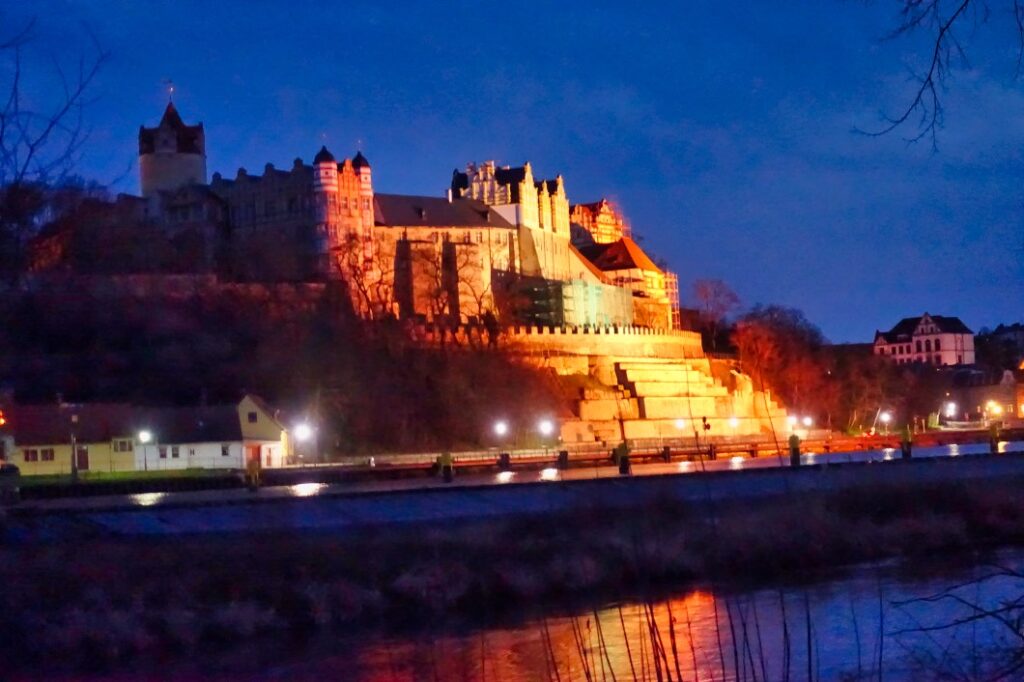
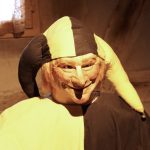
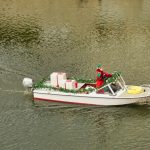
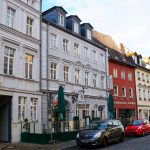
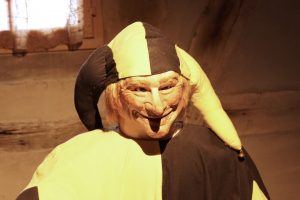
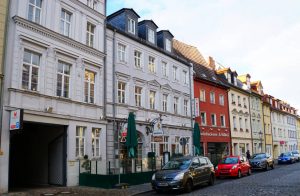
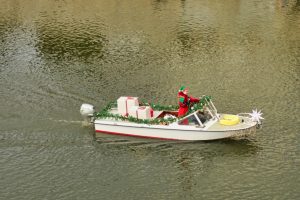
Leave a Reply